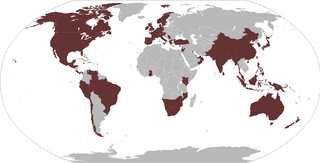
Dame Ninette de Valois was an Irish-born British dancer, teacher, choreographer, and director of classical ballet. Most notably, she danced professionally with Serge Diaghilev's Ballets Russes, later establishing the Royal Ballet, one of the foremost ballet companies of the 20th century and one of the leading ballet companies in the world. She also established the Royal Ballet School and the touring company which became the Birmingham Royal Ballet. She is widely regarded as one of the most influential figures in the history of ballet and as the "godmother" of English and Irish ballet.

Sir Robert Murray Helpmann CBE was an Australian ballet dancer, actor, director, and choreographer. After early work in Australia he moved to Britain in 1932, where he joined the Vic-Wells Ballet under its creator, Ninette de Valois. He became one of the company's leading men, partnering Alicia Markova and later Margot Fonteyn. When Frederick Ashton, the company's chief choreographer, was called up for military service in the Second World War, Helpmann took over from him while continuing as a principal dancer.

The Royal Academy of Dance (RAD) is a UK-based examination board specialising in dance education and training, with an emphasis on classical ballet. The RAD was founded in London, England in 1920 as the Association of Teachers of Operatic Dancing, and was granted a Royal Charter in 1935. Queen Elizabeth II was patron of the RAD and Darcey Bussell was elected to serve as president in 2012, succeeding Antoinette Sibley who served for 21 years.
Rudolf Benesh was a British mathematician who created the Benesh Movement Notation for dancing.

Dame Alicia Markova DBE was a British ballerina and a choreographer, director and teacher of classical ballet. Most noted for her career with Sergei Diaghilev's Ballets Russes and touring internationally, she was widely considered to be one of the greatest classical ballet dancers of the twentieth century. She was the first British dancer to become the principal dancer of a ballet company and, with Dame Margot Fonteyn, is one of only two English dancers to be recognised as a prima ballerina assoluta. Markova was a founder dancer of the Rambert Dance Company, The Royal Ballet and American Ballet Theatre, and was co-founder and director of the English National Ballet.

The Royal Ballet is a British internationally renowned classical ballet company, based at the Royal Opera House in Covent Garden, London, England. The largest of the five major ballet companies in Great Britain, the Royal Ballet was founded in 1931 by Dame Ninette de Valois. It became the resident ballet company of the Royal Opera House in 1946, and has purpose-built facilities within these premises. It was granted a royal charter in 1956, becoming recognised as Britain's flagship ballet company.

The Royal Ballet School is a British school of classical ballet training founded in 1926 by the Anglo-Irish ballerina and choreographer Ninette de Valois. The school's aim is to train and educate outstanding classical ballet dancers, especially for the Royal Ballet and the Birmingham Royal Ballet.

Dame Gillian Barbara Lynne was an English ballerina, dancer, choreographer, actress, and theatre-television director, noted for her theatre choreography associated with two of the longest-running shows in Broadway history, Cats and The Phantom of the Opera. At age 87, she was made a DBE in the 2014 New Year Honours List.
Sir Peter Wright CBE is a British ballet teacher, choreographer, director and former professional dancer. He worked as a choreographer and as the artistic director of Birmingham Royal Ballet, a classical ballet company based in Birmingham, England. On retiring from the company in 1995, he was bestowed the honorary title of Director Laureate of the company.

Dame Margaret van Praagh was a British ballet dancer, choreographer, teacher, repetiteur, producer, advocate and director, who spent much of her later career in Australia.

Dame Beryl Elizabeth Grey was a British ballet dancer.
Dame Merle Park is a British ballet dancer and teacher, now retired. As a prima ballerina with the Royal Ballet during the 1960s and 1970s, she was known for "brilliance of execution and virtuoso technique" as well as for her ebullience and charm. Also admired for her dramatic abilities, she was praised as an actress who "textured her vivacity with emotional details."
Julia Farron was an English ballerina, best known as one of the earliest and all-time youngest members of The Royal Ballet, the leading ballet company based at the Royal Opera House in Covent Garden, London.
Alistair Marriott is an English ballet choreographer and principal character artist of The Royal Ballet.

Pamela May OBE was a Trinidad-born British dancer and teacher of classical ballet. Most noted as one of the earliest members of The Royal Ballet, she was regarded as a versatile dancer; dancing all the established 19th-century classical repertoire, and creating roles in new ballets by Ninette de Valois and Frederick Ashton. After retiring from professional ballet, she became a teacher at the Royal Ballet School, and also served as vice-president of the Royal Academy of Dance.
Marguerite Porter MBE is an English former principal ballet dancer, turned actress and choreographer.
Francis John Hart CBE, was an English ballet dancer, choreographer and artistic director of Ballet West from 1986 to 1997.
Ursula Moreton was a British ballerina and teacher, director of the Royal Ballet School from 1952 to 1968.

Samantha Raine is a dance teacher and an English retired ballerina. She is the ballet mistress of the Royal Ballet, at the Royal Opera House, in London's Covent Garden, having previously been a soloist with the Company.

Joan Benesh was a British ballet dancer who, with her husband Rudolf, created the Benesh Movement Notation, which is the leading British system of dance notation.











